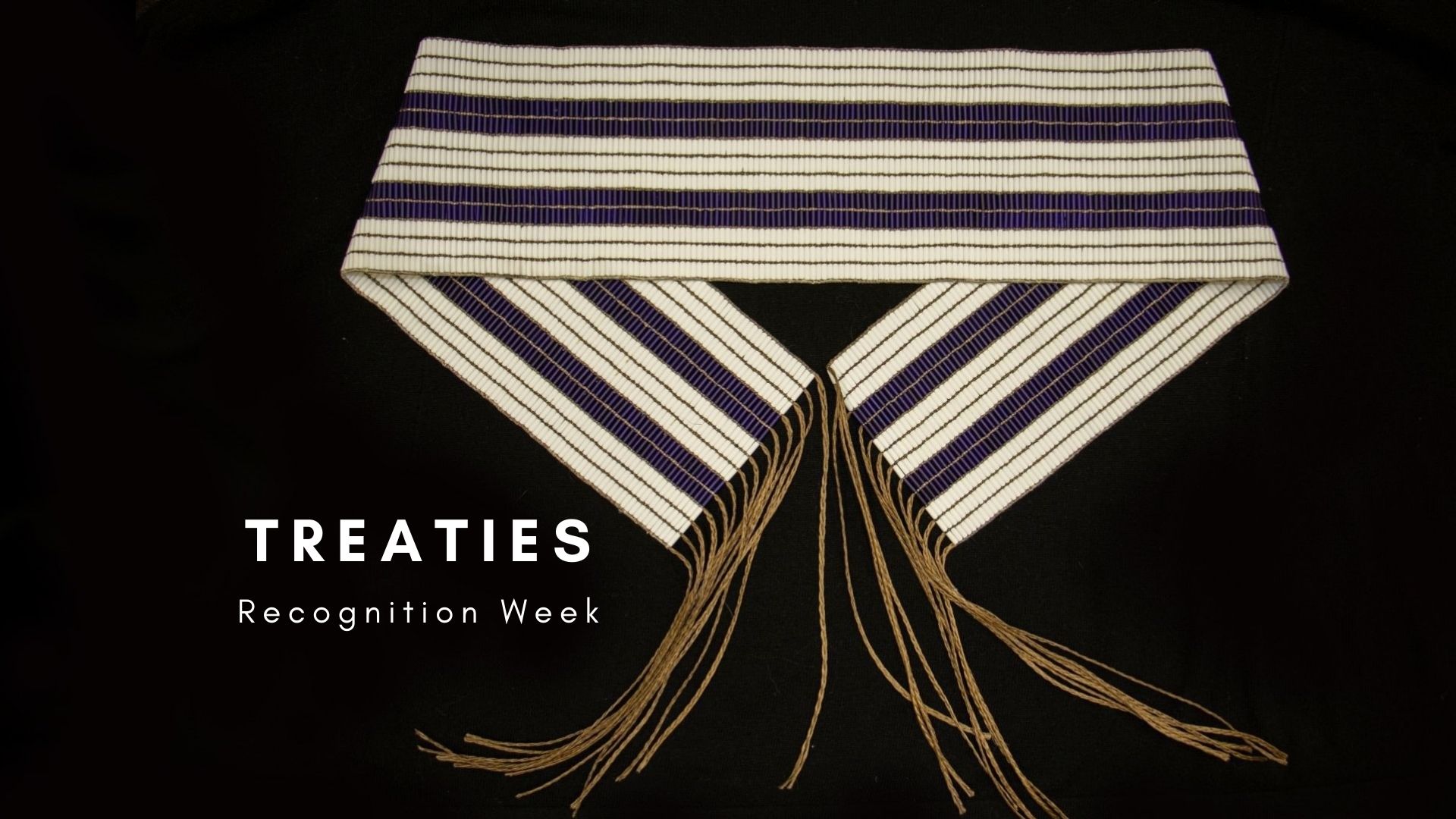
In Ontario, Treaties Recognition Week takes place the first week of November each year and was introduced in 2016 as one way to honour the importance of treaties and to help Ontarians learn more about treaty rights and relationships, as we are all treaty people.
This year the Treaty Canoe by artist Alex McKay will be on display in the Student Research Collaboratory at Leddy Library. The library invites you to explore a variety of resources this week to learn more about treaties and the land that you live, work and gather on.
From print to electronic books, primary archival resources, online videos and even physical replicas of existing treaties in the form of wampum belts, a form of treaty used in 1600’s to establish relationships between certain Indigenous communities and early European settlers.
There are many ways to understand how we are all treaty people.
Treaty Canoe Exhibit
Date: October 28th - November 8th
Location: Student Research Collaboratory, Leddy Library

- About Treaty Canoe
Treaty Canoe (1999, 12’x24”x32”), is built much like a birch bark canoe, except a ‘skin’ of papier-mâché treaties replaces the bark hull. It is made from cedar, red, white, black & yellow ribbon, glue, ink and linen paper.
Treaty Canoe speaks of mutual, sacred bonds of honour and makes clear that we are all treaty people. When exhibited it hangs by a thread balanced on a pivot point above its centre thwart. It responds to the slightest breeze of passers-by, rocking and turning. Lit from above the craft becomes translucent; in casting a shadow it becomes two canoes, floating in the same current on separate but parallel courses, evoking the Two Row Wampum.

Using dip-pen and ink, treaties were ‘transcribed’ performatively by many hands from machine-printed text onto hand-made linen paper to create facsimile documents. In a decolonizing gesture volunteer ‘scribes’, most of whom had never read a treaty before, undertook a close reading and transcription before reluctantly and poignantly signing the contracts in the stead of their original faithful negotiators.
The transcription process becomes a kind of historical re-enactment, a kind of performative time travel. It transports the participants back to the moment of negotiation, coaxing them to ask questions about cultural and linguistic differences, and opposing values.
Invariably these ‘scribes’ choose to transcribe a treaty from where their ancestors originally settled, where they themselves were born, or where they live now, thus learning whose traditional territory (much un-ceded) they occupy. The scribes also begin to question the fairness of the treaty, reflecting on the conditions under which it was negotiated, the crosscultural differences in languages and understanding of terms (even the term ‘treaty’ itself), the disparity between oral and textual authority and concepts of land and property, not to mention the issue of whether the terms of the treaty as printed have actually been kept. The canoe, Indigenous technology, is a national cultural icon. Our cultural myth asserts that through paddling the canoe we can have an unmediated experience of wild ‘nature’ and by becoming part of nature, ‘Indigenize’ ourselves, becoming, in turn, more fully Canadian. Ironically this is done without the majority of Canadians being engaged in any sort of positive relationship with Indigenous people, and with no understanding that they are on someone else’s traditional territory, or in someone else’s sovereign nation.
Marrying treaties to a canoe is an attempt to decolonize the canoe: to question the cultural myths and to point to a relationship where parties treat with honour, as equals, allies, and trading partners, reaching agreements to share the land, resources, and the wealth flowing from them to the mutual benefit of all signatories.
Treaty Canoe is, of course, text. Its sister piece, the megaphone Treaty of Niagara 1764, (birch bark, copper wire, red paint, about 24 x 12 inches, 1999) is all but mute. The Treaty of Niagara, which affirmed Indigenous sovereignty, was negotiated with the many Indigenous nations present following The Royal Proclamation of 1763.
Treaty of Niagara 1764 was inspired in part by Rebecca Bellmore’s performative work Ayumee-aawach Oomama-mowan: Speaking to Their Mother, print historian D.F. Mackenzie’s work on The Treaty of Waitangi entitled The Sociology of Text: Oral Culture, Literacy, and Print in Early New Zealand(http://catdir.loc.gov/catdir/samples/cam032/98031000.pdf) and John Borrows’s Wampum at Niagara. (http://www.chiefs-of-ontario.org/sites/default/files/files/Borrows-WampumAtNiagara%20(2).pdf) These two scholarly works address the authority of oral tradition in law and reveal that Indigenous sovereignty was never relinquished, while Bellmore’s work asserts the authority of Indigenous voice in the flesh, in the spirit, on the land, in the here and now. Unable to speak for Indigenous people, I humbly offer this simple tool, so I can stand aside, and listen.
Treaty Canoe as an Avatar
Treaty Canoe is a manifestation of an intent, a desire for a spirit of understanding and change.

That spirit needs to be in many places, so Treaty Canoe II was editioned in 2013 at Kent University, Canterbury, UK. It is of the same size, materials and process, but has many different treaties in many languages, including The Treaty of Waitangi in Maori. How it resonates in the UK, at the heart of empire, is something we are still sorting out. Treaty Canoe Replica (2018, below, with Silver Dollar, after E. Hahn 1933, behind it) is a 1/7 scale (about 50 cm long) model made to be inserted into the Pitt Rivers Museum, Oxford University. Sadly this project fell through, so I am finding new ways of bringing Treaty Canoe, as Replica, into environs it would otherwise be difficult to achieve. And lastly, in 2012, with Indigenous ally and childhood friend Tory James (self-declared ‘Champion’ of Treaty Canoe), we began Voyageur (unfinished - bottom left) a 19-foot seaworthy edition to be paddled, by volunteers, in, around, and across Turtle Island, spreading the word that We are all Treaty People. Replica below middle with Silver Dollar after E. Hahn behind it, Treaty Canoe at Osgoode Hall below right Recently Dermot Wilson, also long-time Treaty Canoe facilitator and ally has, with many Settler and Indigenous allies from the North Bay Region, joined what was to become The Treaty Canoe Project to form a group to paddle and guide Voyageur to Ottawa for the 150th, but it seems this is not the time to assert Settler voices in the present dialogue, for our Canada Council for the Arts Reconciliation/150th grant application was unsuccessful. It is time to listen to Indigenous voices in the spirit of We are all Treaty People.
- Message from the Artist
"The trick is you have to turn your ghosts into ancestors. Ghosts haunt you. Ancestors walk alongside you and provide you with comfort and a vision of life that’s going to be your own."
- Bruce Springsteen, in conversation with Barak Obama
Exhibiting Treaty Canoe in a library has a certain irony, as it was made to question and undermine the very authority of what is, seemingly, most important to a library, that is text (or books if you like) and give precedence to Indigenous voice and oral history. Treaty Canoe is covered in words, words which should be honoured, but for the fact that they are, in actuality, the wrong words.
The transcription process through which the facsimile treaties covering this canoe were made was designed to push the ‘Scribes’ to do a close reading of a self-chosen treaty, and to reflect upon the complexity of the circumstances of the treaty negotiation, the relationship between the treaty parties, and the disparity between the languages and the cultural means of recording the events of the treaty ceremony, and the treaty itself.
Most Scribes choose a treaty that they felt had personal meaning to them, a treaty for the land upon which their family arrived to Turtle Island, or settled, or where they live now, or perhaps even where their family cottage is.
A couple of weeks ago I heard an Indigenous person on the CBC say that we could discard the Indian act, if only we went back to the treaties, and negotiated treaties for those territories still without one.
Of course the Crown sees treaties as the mechanism by which territories are ceded (to the Crown) and if I understand correctly Indigenous nations see treaties as an acknowledgement of the sovereignty they have always held, and a foundation of an agreement to equitably share the land and the wealth that flows from it. The Crown sees a treaty like a bill of sale, and closed transaction. I don’t believe this to be true. I understand a treaty to be the foundation for ongoing negotiations.
Treaties are a special kind contract, between nations. Under contract law and the contra proferentem rule, a contract/treaty isn’t really what is written down on paper, the agreement is what was understood by both treaty parties at the time the agreement was made, and this understanding is always in favour in opposition to the party that wrote up the contract. If there is a conflict about that understanding the text does not unequivocally carry authority, not since the application of the contra perferentem rule in the United States in 1832.
This understanding of the Indigenous and oral tradition and its authority was affirmed and set international legal precedence through the Treaty of Waitangi Act in 1975, setting up the Waitangi Tribunal, thus entrenching the Treaty of Waitangi as a founding document of Aotearoa - New Zealand.
If you haven’t read a Canadian treaty I think it a necessary part of understanding what it means to be a Canadian. They read like a form of madness, a polite formal fiction that only a fool would sign, or someone lied to about what was actually said on the paper, and what it meant.
During Treaty Week by all means honour the treaties, but not the ones that you can read, instead ask the Indigenous nations what the spirit of the treaties were, really. Look to the Two Row, educate yourselves, and others. Take action as your conscious dictates. Call upon the ancestors to help you understand and walk in the truth.
Alex McKay 2021- Treaty Canoe Resources
- Laura Peers, Address (Welcome delivered at the University of Kent, United Kingdom, October 2013) [unpublished].
- Buchanan, Ruth & Jeffrey G. Hewitt, “Treaty Canoe” in Jessie Hohmann and Daniel Joyce, eds, International Law's Objects(Oxford: Oxford University Press, 2018) 491.
Virtual Events:
Treaties and the Truth and Reconciliation Commission’s Calls to Action
- November 1 from 1:00-2:00 PM, Dr. Cynthia Wesley-Esquimaux will lead “Treaties and the Truth and Reconciliation Commission’s Calls to Action,” an interactive discussion of treaties, their connection to the Truth and Reconciliation Commission’s Calls to Action, and how we can all advance reconciliation. Interested parties can register here.
Trick or Treaty?
- November 2 from 1:30-3:00 PM, Maurice Switzer will present “Trick or Treaty?”, in which he will discuss the ways that the Supreme Court and governments have historically approached treaties. Interested parties can register here.
Red, Right and True: An Indigenous Worldview
- November 5 from 10:30-11:30 AM, Dr. Ruke Redbird will present “Red, Right and True: An Indigenous Worldview.” He will discuss historical prevarications and introduce the audience to a new worldview presented through an Indigenous lens. Interested parties can register here.
Watch: Trick or Treaty
Covering a vast swath of northern Ontario, Treaty No. 9 reflects the often contradictory interpretations of treaties between First Nations and the Crown. To the Canadian government, this treaty represents a surrendering of Indigenous sovereignty, while the descendants of the Cree signatories contend its original purpose to share the land and its resources has been misunderstood and not upheld. Enlightening as it is entertaining, Trick or Treaty? succinctly and powerfully portrays one community’s attempts to enforce their treaty rights and protect their lands, while also revealing the complexities of contemporary treaty agreements. Trick or Treaty? made history as the first film by an Indigenous filmmaker to be part of the Masters section at TIFF when it screened there in 2014.
Trick or Treaty?, Alanis Obomsawin, provided by the National Film Board of Canada
More Resources
- Books
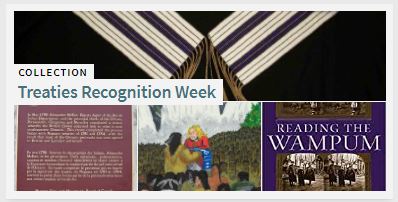
The Leddy Library has prepared a collection of books and other resources regarding local history and treaties for you to explore. It has been supplemented with a collection of children’s materials regarding treaties, and a list of books from a broader perspective regarding treaties from both European and Indigenous perspectives.- Wampum Belts
While European text-based treaties are indeed an important resource to use in the classroom, the Leddy Library provides access to two replica wampum belts for faculty and staff to use in their teaching, the Two Row wampum belt used in 1613 to mark the agreement of Turtle Island and the Dish with One Spoon used in 1701 during the Haudenosaunee Confederacy.
In addition, the Curriculum Resource Centre collection also includes a Lego wampum belt kit “We are all...Treaty people,” for education students to assist in indigenizing the curriculum and decolonizing their classrooms from k-12.
Two Row Wampum
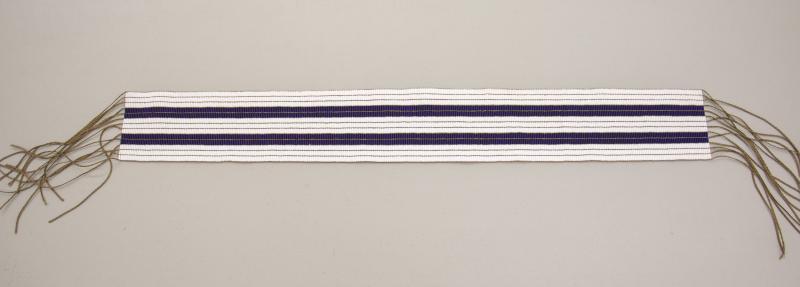
Dish with One Spoon
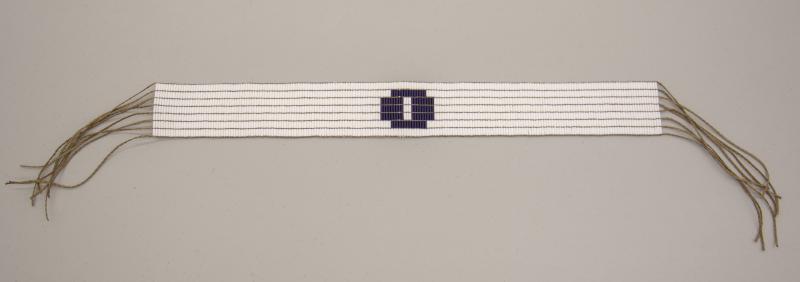
What is Wampum?
Archives & Special Collections
Treaties are part of a wider array of interactions and agreements between Indigenous people and settlers, including land grants such as this one between the Huron and the Jesuits in our area.
The Leddy Library's Archives and Special Collections holds the original copy of this land grant that dates back to 1780.
A digital copy of the Huron and the Jesuits Land Grant, representing an agreement about land the main campus the University of Windsor resides within, can be seen below along with an English translation.
Original Copy of Huron and the Jesuits land grant, 1780:
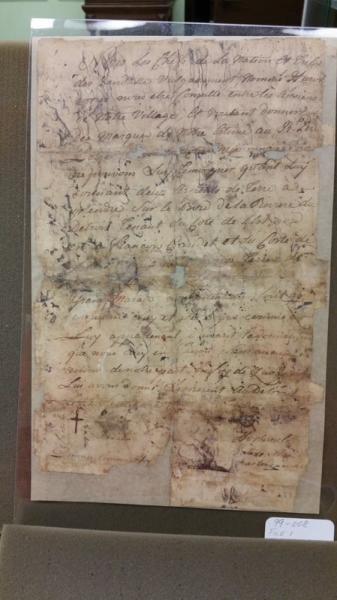
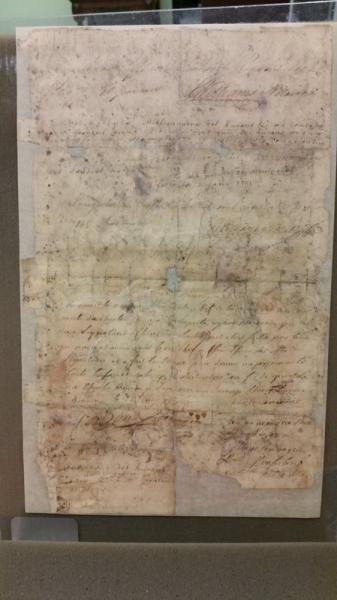
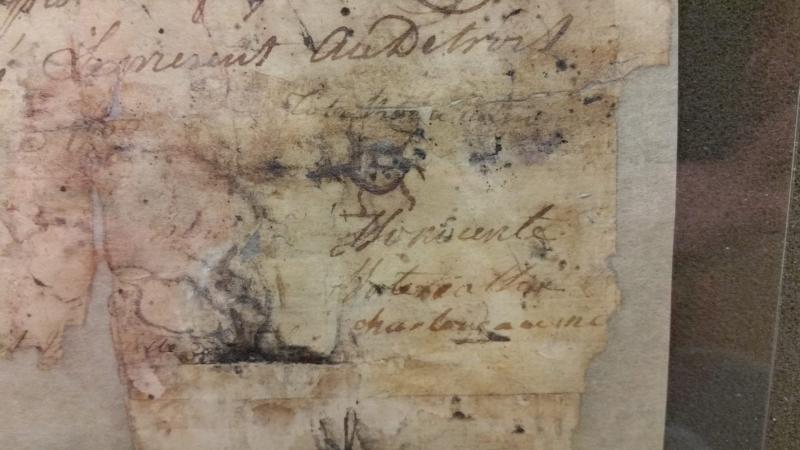
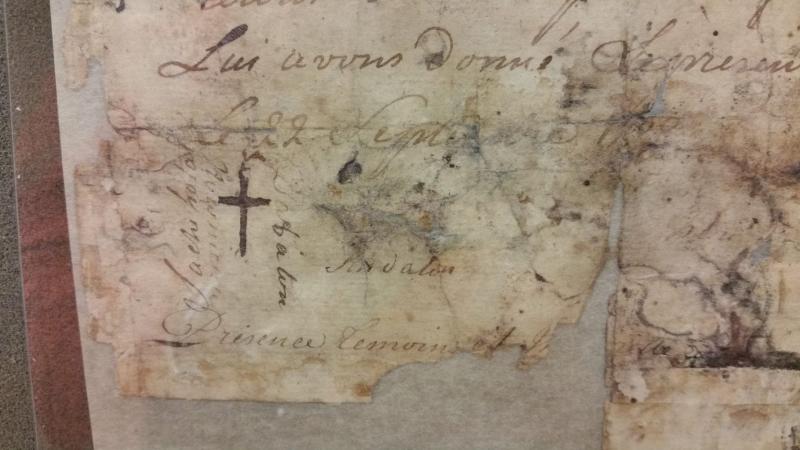
Translation in English:
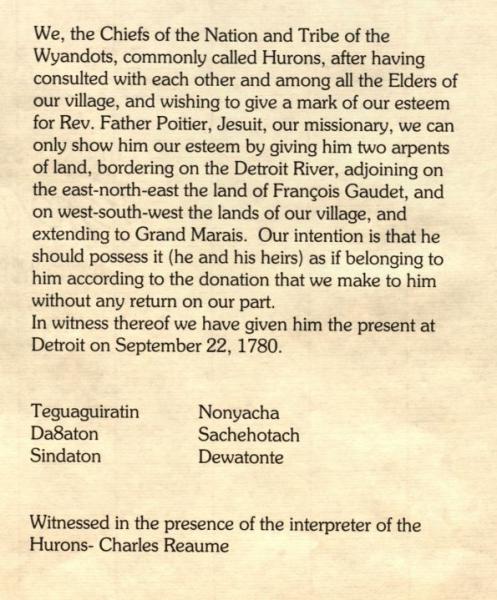
Using GIS to Understand Treaties
- Aboriginal Lands of Canada Legislative Boundaries - Online interactive maps and GIS data for legislative boundaries of Indian Reserves, Land Claim Settlement Lands and Indian Lands for all of Canada.
- First Nations Settled and Unsettled Land Claims in Canada – GIS data includes settled and unsettled land claims in Canada as of 2013, created by the Conservation Biology Institute.
- Historic First Nations Treaties in Canada - GIS datasets that include pre-1930 treaty boundaries, Created by Global Forest Watch Canada.
- Treaties, Claims, and Agreements Maps - Various thematic mapping products on treaties undertaken by the Aboriginal Affairs and Northern Development Canada.
- Maps of Treaty Making in Canada – A series of downloadable maps illustrating the pre-1975 treaty boundaries of Canada, that were negotiated between 1725 and 1923.
- Pan-Inuit Trails – The Atlas provides a synoptic view of Inuit mobility and occupancy in most of the Canadian Arctic, as documented in written historical records (Inuit trails and place names).
- Native Land - an interactive map of Indigenous territories, languages and treaties around the world with a focus on Canada, US, Australia and New Zealand.
- Ontario First Nations Maps - Map of Ontario treaties showing locations of First Nations.
- GIS Resources for Indigenous Studies (Carleton University Library) - A data guide for using geospatial resources for research in Indigenous Studies.
Videos: Indigenous Voices on Treaties
Each year in Ontario, Treaties week is recognized to honour the importance of treaties and to help Ontarians learn about treaty rights and treaty relationships.
The Government of Ontario website has put together 10 videos showcasing Indigenous speakers who share their knowledge about the importance of treaties, treaty relationships and rights in Ontario.
Watch the videos below or visit https://www.ontario.ca/page/videos-indigenous-voices-treaties for more information.Darrell Boissoneau on pre-Confederation treaties
Bentley Cheechoo on treaties’ impact on his family
Gerry Duquette Jr. on treaty responsibilities
Margaret Froh on Métis experiences with treaties
Angela Loft on the importance of gift giving
Sylvia Maracle on how the treaty process has changed
Cora-Lee McGuire-Cyrette on oral history and women’s role in treaty signing
Maurice Switzer on reconciliation and treaty recognition
Anne Taylor on Treaty 20 and land stewardship
Doug Williams on treaties' impact on First Nations languages and cultures

Connect with your library